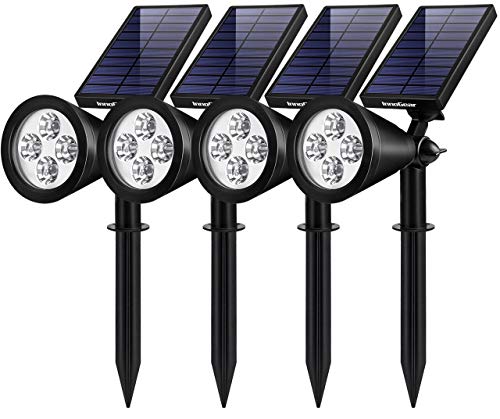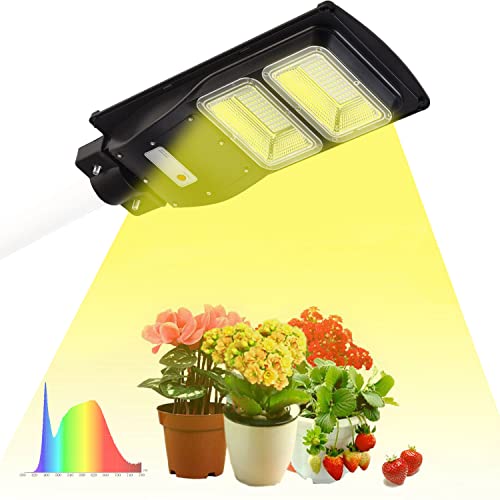Top 16 Solar Grow Lights For Outdoor Plants Of 2024
Brandon Forder May 8, 2024 6:20 AM
When there are so many alternatives for outdoor plant growth lamps, how do you know which one is best for your needs? In our extensive study, we've discovered the best outdoor plant-growing lamps on the market today.
This list of the best outdoor plant growth lamps is the result of more than three weeks of intensive testing of dozens of lamps ranging in price from $20.00 to $149.00. Take a look at a few more of our favorites, plus some helpful advice from our team of seasoned editors.

Compare Products
Last update on 2024-05-08 / Affiliate links / Images, Product Titles, and Product Highlights from Amazon Product Advertising API
Electricity consumption
As a result of the LED light bulb's extended usage (10-12 hours per day), your power bill will rise.
Read the product's brand description attentively, as it could help you make an informed decision and avoid future problems. In addition, make sure to keep track of the overall number of units produced.
Plant growing space
Always keep in mind that the size of the lamps you purchase depends on the amount of space you have in your manufacturing area.
Suppose you're planting in a room, and you need to know how big it is. Then, take a look at the lighting area of the lamp you're selecting for your plant production and figure out how much space you'll need. The number of lamps utilized in a certain space will be determined by the room's size.
According to basic recommendations, you only need to use 32 watts of actual power per square foot if you're planting high-light plants, but you'll need between 11 and 18 watts if you're planting low-light plants like lettuce.
Low heat output
There are two components to this element, making it a critical consideration when evaluating LED lights:
-
Plant protection
-
Durability
Lights with low heat output guarantee that your house plants will not be harmed, but you must keep a smaller space between the lamp and the plant because of this. A high-heat bulb, on the other hand, may cause your plants to get burned more quickly.
Flexibility and ease of use
You may have to prop the lamp up from your plant if it doesn't stay horizontal, so be aware of this when adjusting it. It is more efficient and easier to utilize a high-quality lamp.
Additionally, a function that allows you to alter the light's wavelength and intensity is critical while looking for the best-LED lamps for your plants.
Solar Charging
However, we've known for a long time that solar lights are powered by the sun. Let's take a closer look at this.
A solar panel is used to power solar lights. The sun's light is captured by the solar panels, which then transforms it into usable energy. Our solar lights could be powered straight from the sun's rays if we wanted to.
The larger the panel, the more cells there are. More power is generated by larger solar panels. The more energy you have, the longer you can run. However, the number of solar cells you have doesn't determine how much energy you can generate.
Another element to consider is the amount of direct sunlight.
In the absence of direct sunshine, no matter how many solar cells you have, your system will remain inactive. As a result, the panel must be placed in a location where it will receive sufficient sunshine to charge.
Battery And Capacity
When the sun isn't shining, we need our lights to work. This is where a battery that can be recharged comes in handy. Solar energy is stored in batteries until it is needed. While the sun sets.
The capacity of a battery shows you how much power it can hold. It is possible to store more energy in some batteries than others. Capacity can be measured in milliampere-hours (mAH), which tells you how much power it can hold.
All of this boils down to one thing: mAH informs you how much juice the battery has. The longer the lights stay on, the more battery capacity you have. So, if you're looking for a device with a high mAh count, you should do so.
Batteries are also used to store energy in home wind turbines, albeit on a much greater scale. Check out this post on solar phone chargers for more ideas on how to use solar power.
Activation Feature
What's the best way to turn on the lights in my house? In terms of activation, motion-activated and dusk/dawn are the two most common options.
The sun powers dusk/dawn activation. Whenever the ambient light level drops below a certain threshold, these lights automatically turn on. Once they're turned on, they're not going anywhere till the sun rises (or the battery dies).
In contrast, when something moves near enough, a motion sensor activates the light. Check the sensor sensitivity and range if you prefer this type of activation.
Do sun lamps help plants grow?
When seeds are started indoors, UV light can speed up the germination process. UV strengthens seedlings as they are transplanted to more intense light sources, allowing them to better withstand high intensity light.
Beside this, can any LED light be used as a grow light?
Despite the fact that they may emit some of the wavelengths required by plants, regular LED lights cannot be used as grow lights. Plants need a lot of light, but regular LED lights don't provide it. Red and blue light are essential for plant growth, and LED grow lights are engineered to provide as much of this light as possible.
In respect to this, can you grow plants under lamps?
Plants like houseplants, orchids, and even some fruits and vegetables can be grown indoors using a system of grow lights. Stocky, green seedlings are easier to achieve when using grow lamps for seed starting. During the winter months, herbs and salad greens can be planted under lights for a year-round yield.
Can I leave my grow light on for 24 hours?
Set up a timer for your plant, because it needs a light-dark circle in order to nourish itself properly. It is recommended that the plants receive light for at least 12 hours each day. It's now up to you whether you want to provide 12 hours of light continuously or at irregular periods.
Will 6500K LED grow plants?
Cucumber, lemons, and other citrus fruits and flowers require a lower spectrum light with a color temperature of about 3000K if grown solely from seeds, although root crops and green vegetables can be grown with a 6500K light.
What color light is best for plant growth?
Plants respond best to red and blue light. Yellow and green, on the other hand, emit UV radiation that is harmful to plants. The plants are germinated and grown using red and blue lights.
In terms of convenience and low-maintenance, solar grow lights are an excellent option. Because they are inexpensive, you can save a lot of money by using them. You can choose from a variety of styles that can be hung either horizontally, vertically, or even horizontally on poles or walls. With the solar panel installed outside, you may also use some of the energy indoors to benefit your grow area. We hope that this guidance will be of use to you, based on your preferences. From our other articles, you can learn more about the various sources of light that are available.



























